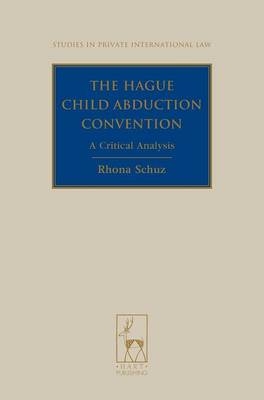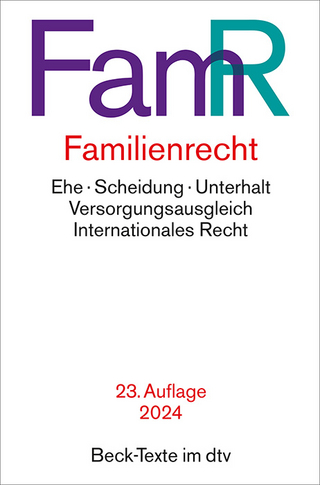
The Hague Child Abduction Convention
Hart Publishing (Verlag)
978-1-84946-017-0 (ISBN)
International child abduction is one of the most emotionally charged and fascinating areas of family law practice. The 1980 Hague Convention on the Civil Aspects of International Child Abduction was the response of the international community to the increase in the phenomenon of parental child abduction. However, behind the widely acclaimed success of this Convention - which has now been ratified by more than 90 states - lie personal tragedies, academic controversy and diplomatic tensions.
The continuing steady flow of case-law from the various Member States has resulted in the emergence of different approaches to the interpretation of key concepts in the Convention. In addition, over the years other global and regional legal instruments and the recommendations of the Special Commissions have had an impact on the implementation of the Convention.
This book brings together all these strands and provides an up-to-date, clear and highly readable discussion of the international operation of the Abduction Convention together with in-depth critical academic analysis in light of the objectives of the Convention and other relevant legal norms, such as the 1989 UN Convention on the Rights of the Child. Throughout the book, examples are brought from case law in many jurisdictions and reference is made to relevant legal and social science literature and empirical research.
Over the past decade, increasing focus has been placed on what might be seen as procedural issues, such as separate representation for children, undertakings, judicial liaison and mediation. The book analyses the significance of these developments and the extent to which they can help resolve the continuing tension between some of the objectives of the Convention and the interests of individual children.
This book will be essential reading for judges, practitioners, researchers, students, policy-makers and others who are seeking a critical and informed analysis of the latest developments in international abduction law and practice.
From the Foreword by Brenda Hale, Justice of the Supreme Court of the United Kingdom
'This book is, as far as I am aware, the first scholarly monograph to study the interpretation and application of the Convention across the whole legal space which it occupies and to critically assess these in light of the object and purposes of the Convention and other relevant legal norms. Cases are drawn from many jurisdictions to discuss how different countries interpret the Convention and links are made with relevant statistical, social and psychological research in a thoughtful discussion of the significance of such material both to judicial decision-making and to policy development…a study which deserves to be read by anyone with an interest in the modern phenomenon of international child abduction, whether judge, practitioner, policy-maker, parent, researcher or scholar. There is plenty for us all to think about.'
Rhona Schuz is Professor of Law and Co-Director of the Center for the Rights of the Child and the Family at Sha'arei Mishpat Law School, Israel (formerly lecturer at the London School of Economics and Political Science). She has published many articles on the topic of International Child Abduction as well as a book and numerous articles on other aspects of Family Law, Children's Rights and Private International Law.
Introduction
Part I – Overview
1. The Birth of the Abduction Convention and its Inter-Relationship with Other Legal Instruments
I The Birth of the Abduction Convention
II Inter-Relationship with Other Legal Instruments
2. The Operation of the Abduction Convention
I Sources of Information and Statistics
II Institutions and other Actors Involved in the Operation of the Convention
III The Abduction Convention Process
IV After Return
3. Inter-Disciplinary Aspects of International Child Abduction
I Sociological Aspects
II Psychological Aspects of Abduction
4. International Relocation and its Inter-Relationship with Child Abduction
I Introduction
II Relocation Law
III Inter-Relationship between Child Abduction and Relocation
Part II – Parameters for Analysis
5. Parameters Relating to Text and Objectives
I Introduction
II Explanation of the Parameters
6. Consistency with General Legal Doctrines
I Introduction
II Rights and Interests of Children
III Rights of Parents
IV Private International Law Principles
V Certainty versus Flexibility
Part III – Conditions for Application of Mandatory Return Mechanism
7. Wrongful Removal or Retention
I Introduction
II Removal or Retention
III Rights of Custody
IV Analysis in Relation to Breach and Exercise of Custody Rights
V Conclusions
8. Habitual Residence
I Introduction
II Role of Habitual Residence in the Abduction Convention
III The Different Models
IV Illustrating the Different Models
V Analysis
VI Conclusions
Part IV – Defences to Mandatory Return
9. Article 12(2)
I Introduction
II The Case Law
III Analysis
IV Conclusions
10. Consent and Acquiescence
I Introduction
II Normative Framework
III Specific Situations
IV Exercise of Discretion
V Analysis
VI Conclusions
11. Grave Risk of Harm
I Introduction
II Interpretation and Application of the Grave Risk Defence
III Protective Measures
IV Analysis
V Conclusions
12. Child's Objection
I Introduction
II Interpretation and Application of Article 13(2)
III Analysis
IV Conclusions
13. Violation of Fundamental Human Rights and Freedoms
I Introduction
II The Case Law
III Analysis
IV Conclusions
Part V: The Voice of the Child
14. Ascertaining the Child's Views
I Requirement to Ascertain the Child's Views
II Method of Ascertaining the Child's Views in Abduction Convention Cases
III Analysis
IV Conclusions
15. Status of the Child in Abduction Convention Proceedings
I Introduction
II The Child's Right to Separate Representation
III Separate Representation in Abduction Convention Cases
IV Application by the Child
V Conclusions
Part VI: Related Proceedings and Processes
16. Mediation
I Introduction
II Advantages of Mediation
III Problems and Solutions
IV Conclusions
17. Compensating the Left-Behind Parent
I Introduction
II To What Extent is Compensation Appropriate?
III Analysis of the Various Models
IV Conclusions
18. Enforcing Rights of Access
I Introduction
II Article 21 of the Abduction Convention
III Other International Instruments
IV Conclusions
Part VII: The Way Ahead
19. Conclusions and Recommendations
I Introduction
II Significance of the Developments Since 1980
III Conclusions
| Erscheint lt. Verlag | 27.11.2013 |
|---|---|
| Reihe/Serie | Studies in Private International Law |
| Verlagsort | Oxford |
| Sprache | englisch |
| Maße | 244 x 169 mm |
| Gewicht | 1043 g |
| Themenwelt | Recht / Steuern ► EU / Internationales Recht |
| Recht / Steuern ► Privatrecht / Bürgerliches Recht ► Familienrecht | |
| ISBN-10 | 1-84946-017-5 / 1849460175 |
| ISBN-13 | 978-1-84946-017-0 / 9781849460170 |
| Zustand | Neuware |
| Haben Sie eine Frage zum Produkt? |
aus dem Bereich


